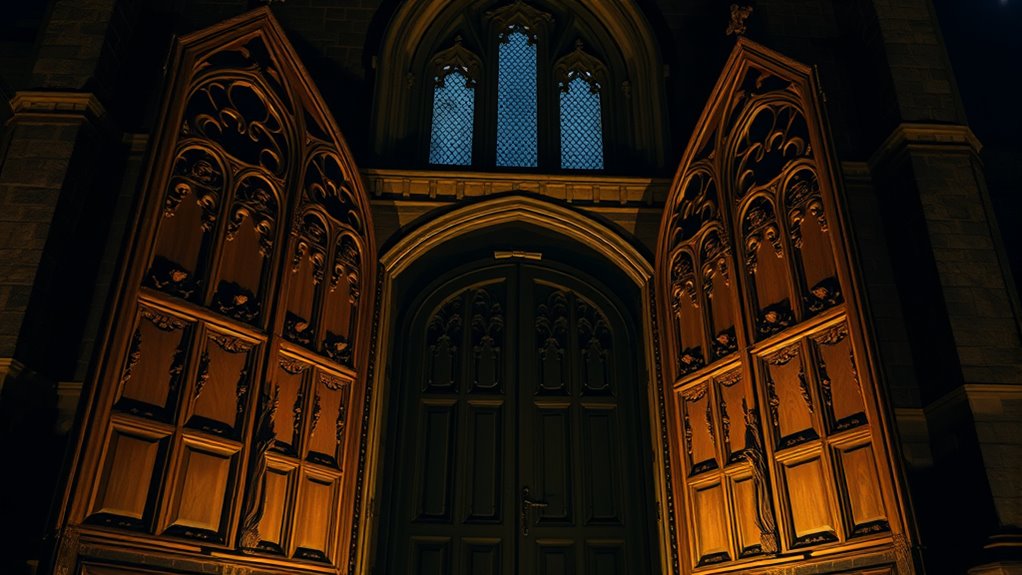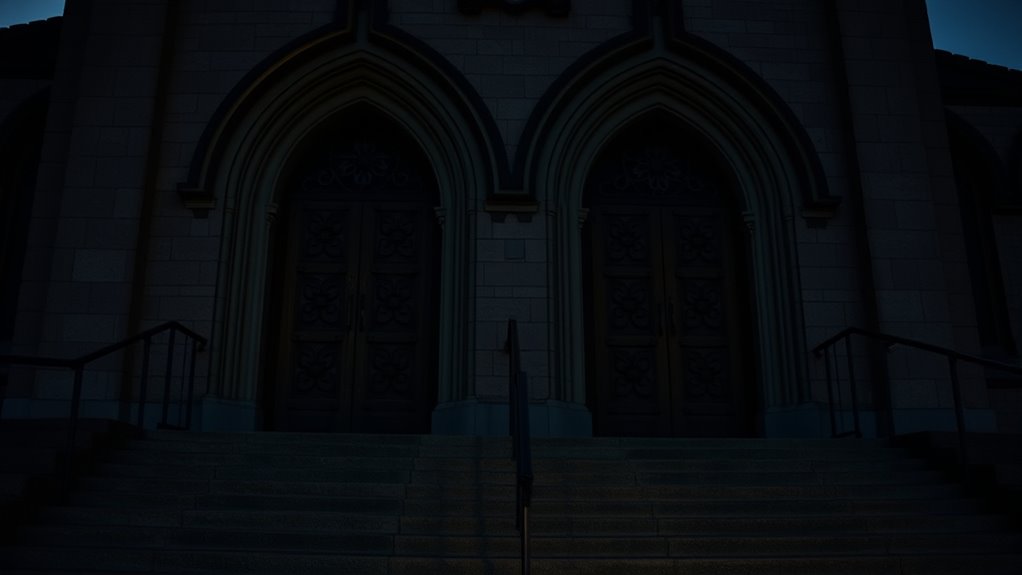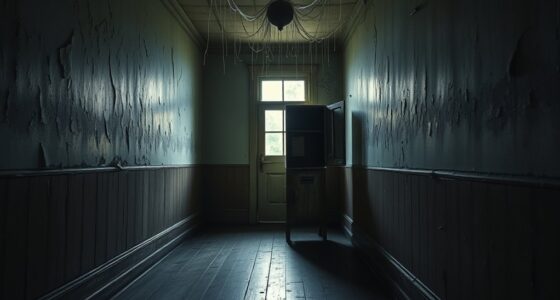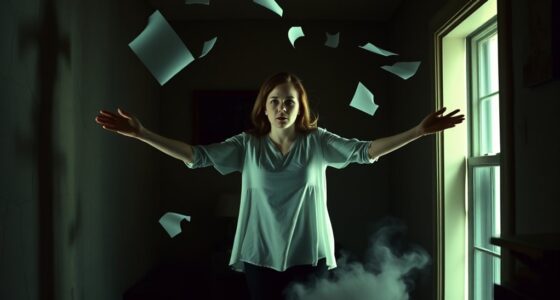At a gothic stone church, you may witness doors opening and closing on their own, often linked to unseen energies or spiritual forces. Its thick wooden and wrought iron doors respond subtly to shifts in atmosphere, while the architecture’s high vaulted ceilings and narrow corridors amplify faint sounds, creating an eerie sensation. These phenomena, combined with the heavy, charged atmosphere, suggest connections beyond the physical world. To uncover what might be causing these unexplained movements, keep exploring the story behind this haunting site.
Key Takeaways
- Doors in the Gothic church open and close autonomously, often attributed to unseen spiritual or supernatural influences.
- Architectural acoustics and design amplify faint sounds, creating the illusion of unseen movements and nearby voices.
- Environmental factors like tremors, flickering lights, and atmospheric heaviness heighten perceptions of spiritual activity.
- The church’s historical ambiance and architecture foster beliefs that unexplained door movements signify supernatural presence.
- The combination of design, acoustics, and atmosphere makes the phenomenon compelling and widely regarded as evidence of unseen forces.

At first glance, the Gothic stone church appears quiet and steadfast, but visitors often report strange occurrences: doors mysteriously opening and closing on their own, even when no one is nearby. These events are often attributed to spiritual manifestations, as many believe the church’s history and atmosphere foster a connection to the unseen domain. When you step inside, it’s easy to sense a heaviness in the air, a feeling that something beyond the physical is at play. The architecture itself contributes to this eerie sensation, especially when you consider the church’s architectural acoustics. The high vaulted ceilings, stone walls, and narrow corridors create unique sound reflections, amplifying even the slightest noises. It’s as if the building itself is alive, capable of echoing whispers or footsteps that aren’t visible to the eye.
The Gothic church’s architecture amplifies whispers and footsteps, making unseen forces seem closer and more mysterious.
You might notice that the doors don’t just move randomly; they seem to respond to unseen energies or presence. Some visitors report hearing faint whispers or footsteps just as the doors swing open or shut, reinforcing the belief that spiritual manifestations are occurring. The architectural acoustics play a vital role here, making these sounds seem closer and more tangible, heightening the overall sense of mystery. The way sound travels within the church can sometimes give the impression that voices are nearby, even when no one else is around. This interplay between sound and space intensifies the feeling that spirits or otherworldly entities could be influencing the environment.
As you observe the doors, you might also notice their old, heavy construction—crafted from thick wood and wrought iron—that seem to respond to subtle shifts in energy. The building’s design, intended for grandeur and reverence, inadvertently creates perfect conditions for acoustic phenomena that amplify these spiritual manifestations. When the doors move, it’s often accompanied by a slight tremor in the air or a flicker of light, which many interpret as signs of spiritual activity. The combination of architectural acoustics and the church’s storied past makes these occurrences feel even more authentic and unsettling.
In essence, the church’s architecture not only shapes its visual presence but also influences how sound and energy behave within. The result is a space where spiritual manifestations seem to come alive—audible whispers, unexplained movements, and the sense that unseen forces are at work. Whether you believe in spirits or not, you can’t deny the powerful atmosphere created by the church’s design and history, making it a truly compelling setting for these mysterious door movements.
Frequently Asked Questions
Has Anyone Experienced Physical Injuries From the Moving Doors?
You might not have experienced injuries from the moving doors, but it’s possible if the door mechanism is faulty or if wind influence causes sudden swings. Always stay cautious around the doors, especially if they begin to move unexpectedly. Make certain the mechanism is maintained properly, and be aware of how strong gusts can influence the doors’ movement. Taking these precautions can help prevent potential injuries caused by unpredictable door movements.
Are There Any Historical Records of Similar Phenomena in the Church?
Coincidences often spark curiosity, and you’ll find that historical documentation and ghost stories from the church reveal similar unexplained phenomena. Records mention mysterious door movements dating back centuries, fueling local legends. Though no definitive proof exists, these accounts suggest a long-standing pattern of strange activity, blending history and folklore. You might consider these stories as part of the church’s haunted heritage, echoing through generations.
Could the Door Movements Be Caused by Structural Issues?
Yes, the door movements could be caused by structural instability or acoustic vibrations. If the building’s foundation is shifting or the walls are weakening, it can lead to door misalignments and movement. Additionally, loud noises or sound waves from nearby activities might create vibrations strong enough to cause the doors to open or close unexpectedly. You should investigate both structural integrity and environmental factors to pinpoint the cause.
Have Any Paranormal Investigations Confirmed Supernatural Activity?
Coincidences often fuel speculation, but no paranormal confirmation exists from investigations. You’ll find that investigation findings consistently point to natural causes like drafts or structural shifts, rather than supernatural activity. Despite numerous tests and recordings, no credible evidence of paranormal presence has emerged. Consequently, the unexplained door movements are best attributed to environmental factors, not supernatural forces, even though the idea persists in local folklore and anecdotal accounts.
What Specific Times Do the Doors Most Frequently Move?
You notice the door timing mostly occurs during late evening and early mornings, roughly between 11 PM and 3 AM. The movement patterns show doors opening and closing unexpectedly, often without wind or human contact. These irregularities suggest a connection to specific times, possibly linked to paranormal activity. Pay close attention during these periods, as the doors seem to follow a mysterious rhythm that might reveal more about the unseen forces at play.
Conclusion
As you stand there, watching the ancient doors swing open and shut on their own, it feels like a coincidence—like the wind catching just right or a hidden draft. Yet, the quiet creak echoes through the stone halls, whispering secrets only the church knows. Sometimes, the universe plays little tricks, blending the seen with the unseen. In that moment, you realize these coincidences weave the mysterious history of this gothic sanctuary, leaving you both curious and captivated.









